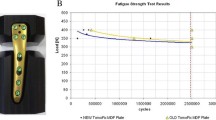Abstract
Purpose
Little is known regarding the biomechanical stability and stiffness of implants and techniques used in supracondylar femur osteotomies (SCO). Therefore, fixation stability and stiffness of implants to bone was investigated under simulated physiological loading conditions using a composite femur model and a 3D motion-analysis system.
Methods
Five osteotomy configurations were investigated: (1) oblique medial closing-wedge fixated with an angle-stable implant; (2) oblique and (3) perpendicular medial closing-wedge, both fixated with an angled blade plate; and lateral opening-wedge fixated with (4) a spacer plate and (5) an angle-stable lateral implant. The motion measured at the osteotomy was used to calculate the stiffness and stability of the constructs.
Results
The least amount of motion and highest stiffness was measured in the medial oblique closing-wedge osteotomy fixated with the angled blade plate. The lateral opening-wedge techniques were less stable and had a lower stiffness compared with the medial; the oblique saw cuts were more stable and had a higher stiffness than the perpendicular.
Conclusion
This experimental study presents baseline data on the differences in the primary stability of bone–implant constructs used in SCO. The data in this study can be used as reference for future testing of SCO techniques. Furthermore, it is recommended that based on the differences found, the early postoperative rehabilitation protocol is tailored to the stability and stiffness of the fixation method used.







Similar content being viewed by others
References
Agneskirchner JD, Freiling D, Hurschler C, Lobenhoffer P (2006) Primary stability of four different implants for opening wedge high tibial osteotomy. Knee Surg Sports Traumatol Arthrosc 14:291–300
Brinkman JM, Lobenhoffer P, Agneskirchner JD, Staubli AE, Wymenga AB, van Heerwaarden RJ (2008) Osteotomies around the knee: patient selection, stability of fixation and bone healing in high tibial osteotomies. J Bone Joint Surg Br 90:1548–1557
Cusick RP, Lucas GL, McQueen DA, Graber CD (2000) Construct stiffness of different fixation methods for supracondylar femoral fractures above total knee prostheses. Am J Orthop 29:695–699
Dvir Z, Prushansky T (2000) Reproducibility and instrument validity of a new ultrasonography-based system for measuring cervical spine kinematics. Clin Biomech 15:658–664
Firoozbakhsh K, Behzadi K, DeCoster TA, Moneim MS, Naraghi FF (1995) Mechanics of retrograde nail versus plate fixation for supracondylar femur fractures. J Orthop Trauma 9:152–157
Franco V, Cipolla M, Gerullo G, Gianni E, Puddu G (2004) Open wedge osteotomy of the distal femur in the valgus knee. Orthopade 33:185–192
Frigg R (2003) Development of the locking compression plate. Injury 34(Supplement 2):6–10
van Heerwaarden RJ, Wymenga AB, Freiling D, Lobenhoffer P (2007) Distal medial closed wedge varus femur osteotomy stabilized with Tomofix plate fixator. Op Tech Orthopaedics 17:12–21
Heiner AD, Brown TD (2001) Structural properties of a new design of composite replicate femurs and tibias. J Biomech 34:773–781
Hsu RW, Himeno S, Coventry MB, Chao EY (1990) Normal axial alignment of the lower extremity and load-bearing distribution at the knee. Clin Orthop 90:215–227
Learmonth ID (1990) A simple technique for varus supracondylar osteotomy in genu valgum. J Bone Joint Surg Br 72:235–237
Luo CF (2004) Reference axes for reconstruction of the knee. Knee 11:251–257
Marti RK, Schröder J, Witteveen A (2000) The closed wedge varus supracondylar osteotomy. Oper Tech Sports Med 8:48–55
McDermott AG, Finklestein JA, Farine I, Boynton EL, MacIntosh DL, Gross A (1988) Distal femoral varus osteotomy for valgus deformity of the knee. J Bone Joint Surg Am 70:110–116
Miniaci A, Grossmann SP, Jakob RP (1990) Supracondylar femoral varus osteotomy in the treatment of valgus knee deformity. Am J Knee Surg 3:65–73
Miniaci A, Watson LW (2002) Distal femoral osteotomy. In: Fu FF (ed) Knee surgery, 1994. Williams & Wilkins, New York, pp 1173–1180
Stahelin T, Hardegger F, Ward JC (2000) Supracondylar osteotomy of the femur with use of compression Osteosynthesis with a malleable implant. J Bone Joint Surg Am 82:712–722
Stahelin T, Hardegger F (2004) Incomplete, supracondylar femur osteotomy. A minimally invasive compression osteosynthesis with soft implant. Orthopade 33:178–184
Staubli AE, De Simoni C, Babst R, Lobenhoffer P (2003) TomoFix: a new LCP-concept for open wedge osteotomy of the medial proximal tibia—early results in 92 cases. Injury 34(Suppl 2):55–62
Stoffel K, Dieter U, Stachowiak G, Gachter A, Kuster MS (2003) Biomechanical testing of the LCP—how can stability in locked internal fixators be controlled? Injury 34(Suppl 2):11–19
Stoffel K, Stachowiak G, Kuster M (2004) Open wedge high tibial osteotomy: biomechanical investigation of the modified Arthrex Osteotomy Plate (Puddu Plate) and the TomoFix Plate. Clin Biomech 19:944–950
Szivek JA, Weng M, Karpman R (1990) Variability in the torsional and bending reponse of a commercially available composite “femur”. J Appl Biomater 1:183–186
Wagner M (2003) General principles for the clinical use of the LCP. Injury 34(Suppl 2):31–42
Walsh JC, Quinlan JF, Stapleton R, FitzPatrick DP, McCormack D (2007) Three-dimensional motion analysis of the lumbar spine during “free squat” weight lift training. Am J Sports Med 35:927–932
Zlowodzki M, Williamson S, Cole PA, Zardiackas LD, Kregor PJ (2004) Biomechanical evaluation of the less invasive stabilization system, angled blade plate, and retrograde intramedullary nail for the internal fixation of distal femur fractures. J Orthop Trauma 8:494–502
Acknowledgments
The respective manufacturers provided all plates and screws; they had no influence on the study itself in any way, shape or form, however. No additional funding was received for this study.
Author information
Authors and Affiliations
Corresponding author
Rights and permissions
About this article
Cite this article
Brinkman, JM., Hurschler, C., Agneskirchner, J.D. et al. Axial and torsional stability of supracondylar femur osteotomies: biomechanical comparison of the stability of five different plate and osteotomy configurations. Knee Surg Sports Traumatol Arthrosc 19, 579–587 (2011). https://doi.org/10.1007/s00167-010-1281-3
Received:
Accepted:
Published:
Issue Date:
DOI: https://doi.org/10.1007/s00167-010-1281-3




